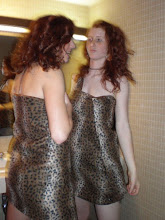
As part of our orientation yesterday, Renjan took us to a fairly popular temple known to tourists as the Monkey Temple, and to locals as Swayambunath. The grounds of the temple extend on for many acres, over a major hill that has pathways carved into it that hundreds of Buddhists walk on in prayer and meditation (the full path takes about 4 hours.) We walked to the top, where the stupa is located, and watched the rhesus macaques flood the grounds. After Renjan gave us all bindis (the red mark on the forehead), we went to lunch at a sherpa cafe.
At the cafe, we were sitting and waiting for our food, when a road child came up behind Joyce, an intern, and tapped her on the back (begging for money or food.) Immediately, the waitress yelled for the owner, who came charging out towards the child. The boy just stared up at him as the man slapped him directly across the face. It wasn't staring due to shock; more like staring from being high, and not really understanding what was going on. This sort of catatonic state from the boy continued, even when the owner grabbed a long reed stick and chased the boy down the road, whipping him across the back.
As we discovered tonight after going to dinner in Thamel, a good percentage of the road children here are severely addicted to drugs, most popularly, glue. We saw over 20 children tonight wandering the streets in packs, with more than half of them holding paper bags to their face, so as to properly inhale the glue.
We saw children like these today during our first real time at the hospital. Working at the hospital can't be better explained than describing it as being a full-fledged medical student. The interns and I are put on rotation--we go from ward, to ER, to surgery, to O.B./GYN, and then back again. But medical students? Have no where near the amount of freedom we have. Today, for instance, we strolled into the ward, having not yet met up with Dr. Gupta (it was 11, he wasn't in yet--very normal), and picked out a patient, looked at her x-rays (in front of her family and herself) and requested her file (high WBC, fever, abdominal pain--suggests enteric fever.) We did this for every patient in the ward, without even seeing an actual doctor the entire time. We even wandered into the lab to check out the equipment and the nurses didn't even look up at us.
As Dr. Gupta puts it, "You are white--you are 3/4 of way there on journey to being doctor."
Which is not to suggest that the Nepali doctors are in any way incompetent. In fact, every doctor I've met so far is more qualified to be a doctor than the woman I see in Grinnell, IA, who lets me prescribe myself. The major difference is a.) funds and b.) sanitation, but it is hard to have such standards of sanitation without the means to provide. What they do here for less than 1 USD here, we do for over 1000.
Interesting.

No comments:
Post a Comment